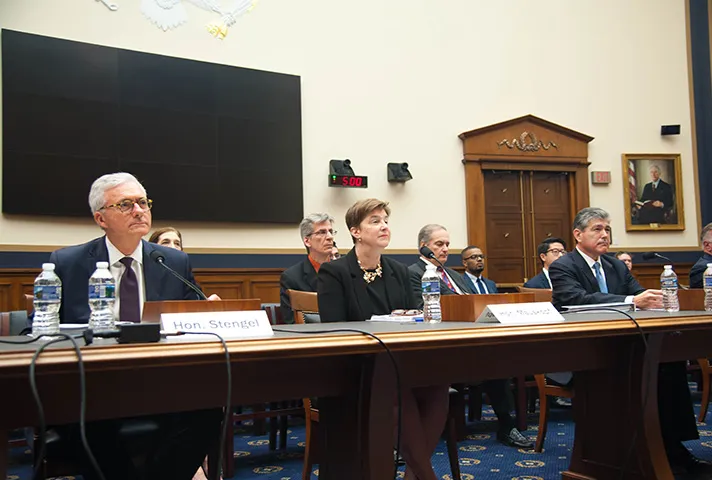
Chief Judge Lawrence Stengel, Judge Roslynn Mauskopf, and Judge Dana Sabraw, left to right, testify at a Congressional hearing on "Examining the Need for New Federal Judges" on June 21, 2018.
“The lack of additional judgeships, combined with the growth in caseload, has created difficulties for many courts across the nation,” Chief Judge Lawrence Stengel told a House subcommittee today. “It has reached urgent levels in five districts that are struggling with extraordinarily high and sustained workload,” he said in prepared testimony. The courts are the: Eastern District of California, District of Delaware, Southern District of Florida, Southern District of Indiana, and Western District of Texas.
The hearing on “Examining the Need for New Federal Judges” was held by the House Judiciary Subcommittee on Courts, Intellectual Property, and the Internet. Testifying on behalf of the Judicial Conference, the federal Judiciary’s policymaking body, were Stengel, chair of the Judicial Resources Committee; Judge Roslynn Mauskopf, chair of the Judicial Statistics Subcommittee; and Judge Dana Sabraw, a district court judge in Southern California.
The Judicial Conference every two years conducts a survey of the judgeship needs of the U.S. courts of appeals and district courts. Based on the latest survey, the Conference in March 2017 recommended that Congress create five new judgeships in one court of appeals and 52 new judgeships in 23 district courts. The Conference also recommended that eight existing temporary judgeships be converted to permanent status. Since the last comprehensive judgeship bill was enacted for the U.S. courts of appeals and district courts, the numbers of cases filed in those courts have grown by 40 percent and 38 percent, respectively.
“Before a judgeship recommendation is transmitted to Congress, it undergoes careful consideration and review at six levels within the Judiciary,” Mauskopf said. Caseload and other court- specific information are considered, as well as several additional factors, including the number of senior judges, the availability of magistrate judges to assist on cases, and any unusual caseload complexities. “Courts requesting additional judgeships are specifically asked about their efforts to make use of all available options,” she said.
Judge Sabraw provided the subcommittee with insight into the special challenges facing the federal district courts in California. Ten percent of the nation’s caseload exists in the four district courts in the state. Since fiscal year 2003, the last year new judgeships were created, weighted case filings in the Southern District of California, where Judge Sabraw sits, have risen 33 percent. Weighted case filings are a way of measuring the time it takes for judges to resolve different types of cases. Based on the most recent data and trends, the court expects the upward trend in weighted case filings to continue.
The workload situation in each of the California districts is severe. For example, in the Eastern District, the average time between a case being filed and going to trial averages four years, nearly twice the national average.
“Delays increase expenses for civil litigation and may increase the length of time criminal defendants are held pending trial,” Sabraw said. “Substantial delays lead to lack of respect for the Judiciary and the judicial process. The problem is so severe that potential litigants may be avoiding federal court altogether.”
The Judicial Conference has requested 17 additional judgeships for California – seven in the Central District, five in the Eastern District, three in the Southern District, and two in the Northern District.
Subscribe to News Updates
Subscribe to be notified when the news section is updated.
